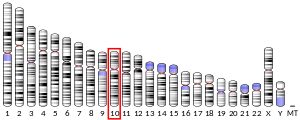TECTB
Beta-tectorin is a protein that in humans is encoded by the TECTB gene.[5]
| TECTB | |||||||||||||||||||||||||
|---|---|---|---|---|---|---|---|---|---|---|---|---|---|---|---|---|---|---|---|---|---|---|---|---|---|
| Identifiers | |||||||||||||||||||||||||
| Aliases | TECTB, tectorin beta | ||||||||||||||||||||||||
| External IDs | OMIM: 602653 MGI: 109574 HomoloGene: 7568 GeneCards: TECTB | ||||||||||||||||||||||||
| |||||||||||||||||||||||||
| |||||||||||||||||||||||||
| |||||||||||||||||||||||||
| Orthologs | |||||||||||||||||||||||||
| Species | Human | Mouse | |||||||||||||||||||||||
| Entrez | |||||||||||||||||||||||||
| Ensembl | |||||||||||||||||||||||||
| UniProt | |||||||||||||||||||||||||
| RefSeq (mRNA) | |||||||||||||||||||||||||
| RefSeq (protein) | |||||||||||||||||||||||||
| Location (UCSC) | Chr 10: 112.28 – 112.31 Mb | Chr 19: 55.18 – 55.2 Mb | |||||||||||||||||||||||
| PubMed search | [3] | [4] | |||||||||||||||||||||||
| Wikidata | |||||||||||||||||||||||||
| |||||||||||||||||||||||||
Function
The genes for alpha-tectorin and beta-tectorin (this protein) encode the major noncollagenous proteins of the tectorial membrane of the cochlea.[5]
gollark: hax.
gollark: What does it want me to do, use a "file"?
gollark: Scheme just APPARENTLY dislikes my mmaped map somewhat?
gollark: BEE, `MAP_SHARED` didn't help.
gollark: No, that could be done much more easily.
References
- GRCh38: Ensembl release 89: ENSG00000119913 - Ensembl, May 2017
- GRCm38: Ensembl release 89: ENSMUSG00000024979 - Ensembl, May 2017
- "Human PubMed Reference:". National Center for Biotechnology Information, U.S. National Library of Medicine.
- "Mouse PubMed Reference:". National Center for Biotechnology Information, U.S. National Library of Medicine.
- "Entrez Gene: tectorin beta".
Further reading
- Legan PK, Rau A, Keen JN, Richardson GP (1997). "The mouse tectorins. Modular matrix proteins of the inner ear homologous to components of the sperm-egg adhesion system". J. Biol. Chem. 272 (13): 8791–801. doi:10.1074/jbc.272.13.8791. PMID 9079715.
- Strausberg RL, Feingold EA, Grouse LH, et al. (2002). "Generation and initial analysis of more than 15,000 full-length human and mouse cDNA sequences". Proc. Natl. Acad. Sci. U.S.A. 99 (26): 16899–903. doi:10.1073/pnas.242603899. PMC 139241. PMID 12477932.
- Deloukas P, Earthrowl ME, Grafham DV, et al. (2004). "The DNA sequence and comparative analysis of human chromosome 10". Nature. 429 (6990): 375–81. doi:10.1038/nature02462. PMID 15164054.
- Rose JE, Behm FM, Drgon T, et al. "Personalized smoking cessation: interactions between nicotine dose, dependence and quit-success genotype score". Mol. Med. 16 (7–8): 247–53. doi:10.2119/molmed.2009.00159. PMC 2896464. PMID 20379614.
- Gerhard DS, Wagner L, Feingold EA, et al. (2004). "The status, quality, and expansion of the NIH full-length cDNA project: the Mammalian Gene Collection (MGC)". Genome Res. 14 (10B): 2121–7. doi:10.1101/gr.2596504. PMC 528928. PMID 15489334.
- Grupe A, Li Y, Rowland C, et al. (2006). "A scan of chromosome 10 identifies a novel locus showing strong association with late-onset Alzheimer disease". Am. J. Hum. Genet. 78 (1): 78–88. doi:10.1086/498851. PMC 1380225. PMID 16385451.
This article incorporates text from the United States National Library of Medicine, which is in the public domain.
This article is issued from Wikipedia. The text is licensed under Creative Commons - Attribution - Sharealike. Additional terms may apply for the media files.



